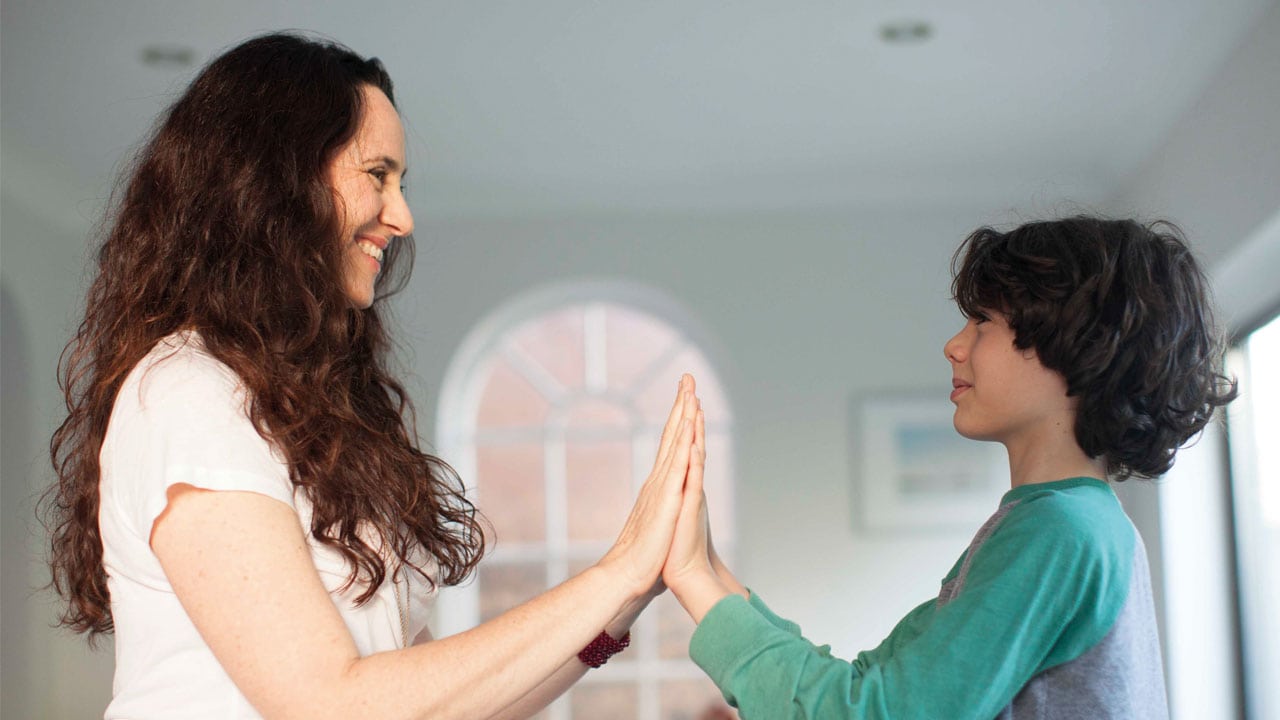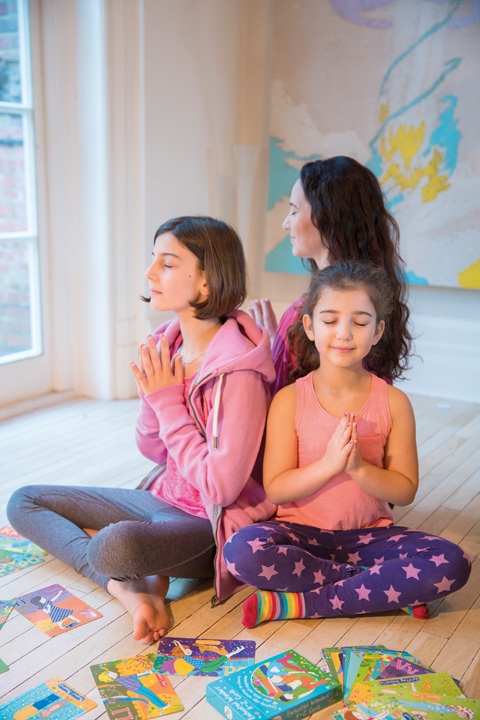
Connected by breath
Using breathing practices and co-regulation to reduce stress in children. By Ayalá Homossany
A five-year-old boy came up to me after a family yoga session recently and told me that his favourite part of the class was doing the breathing exercises with his mum. He described how he loved the part where he rested his hand on her back and found her breath. “It felt like it was playing hide and seek with me,” he grinned.
I thought it was very sweet and shows that a connection through breath awareness can be made from a very young age.
I have found that children and families are very receptive to learning about breathing, especially if it’s done in a fun way using imagination, games, sounds, and movement.
Being aware of our breathing patterns and learning how to use them can be useful in helping us to reduce stress. By changing the pattern and location of our breathing we are able to change our emotional state and balance between the stress response (fight or flight) and the calming and soothing response (rest and digest).
Our children have the ability to sense when we feel happy, sad, stressed, or calm.
By breathing together with our child, we become aware of and in tune with each other, offering our child an opportunity to see us when we are calm, enjoying the here and now, rather than rushing around doing many things at the same time.
Children learn best from example, and seeing us being calm, peaceful, and focused is likely to have the same effect on them. And, in turn, inviting our children to share breathing practices with us will have a calming effect on our own mental and emotional state. In other words, when we use this mutual parent-child process to calm a child’s nervous system, when our child relies on us to help them make sense of how they feel, why they feel that way and what they can do about it, we are using co-regulation.
Breathing is something you can do to connect with your child even if you only have a few minutes to spare.
Noticing the breath
Children under the age of four sometimes find it tricky to grasp the concept of finding their breath and these simple practices can really help.
Invite your child to place one palm in front of their mouth and blow into it. Ask them if they notice how their breath feels. Is it warm or cold?
Blow into a straw aiming it at your child’s palm, arm or leg so they can feel the softness and the stream of the breath. They might even feel that it tickles them. Invite them to do it themselves and then do it to you.
Blow slowly through a straw into a glass filled with water to create a stream of bubbles. Can you make the bubbles the same size as you blow?
Finding the breath
The beauty of this practice is it can be done anywhere and anytime. You and your child can lie down on the floor, sit down together or stand up – whatever feels the most comfortable for you both.
Explore with your child where they can sense their breath. Is it in their chest, their belly, their throat, maybe the nose.
Can either of you notice the pace of the breath?
Partner poses are a lovely way to encourage connection between you and your child or between siblings or friends. Studies show that feeling disconnected or lonely increases the activity of the sympathetic nervous system, the part of the nervous system responsible to the fight or flight response. In particular, loneliness seems to affect the hypothalamic-pituitary-adrenal (HPA) axis, which governs the stress hormones’ roles in the stress response.
When exploring partner poses together with your child notice how these poses encourage not just a physical connection between you and your child but an emotional one too.

Back-to-back bonding
Sitting down on the floor, or on a chair, with you facing opposite ways with your backs touching. Sensing how your backs support each other while noticing which other areas of your bodies are touching such as your head or arms, your shoulders and your bottom.
Chat to each other as you sit back to back. Can you feel each other’s breath in your back? How does it feel to sit this way? Notice the rhythm of your breath. Is it a full deep breath or maybe a shallow and weak one? Or just enjoy the sensation of feeling your partner breathe into your back.
Explore which parts of your body are moving when you breathe and how our breath travels through the spine as you inhale and exhale.
Adding the bumblebee breath (Bhramari breath) while sitting back to back might reveal new sensations as well as add playfulness to the whole practice. As you both take a slow, in-breath through the nose, cover your ears and on the exhale, hum like a bee. Then repeat with the next exhale. Try a different octave to your voices and bring your attention to the vibration the humming sounds created in your body. You might also want to try humming different sounds such as ‘Zzzzzz’ or ‘Ahhhh’
Breathing buddies
The ability to use our body language as a tool to say to our child, “I hear you, I see you, I feel you”, is invaluable.
The aim of this practice is to connect movement to breath and your movement and breath with your child and explore what message it sends out as you practice it together. When we move together and breathe together, we say without words “I am here, now, with you”.
Sitting facing each other, you and your child, have the palms of your hands touching in front of you. As you breathe in, bring your hands to open sideways, still touching. As you breathe out, bring your hand back to the centre.
Try to maintain an even count for the inhale and the exhale to a number that will suit your child.
Suggested respiratory rates for healthy children are:
Children 3-4 years old breathe 8-12 breaths per minute.
Children age 5-7 years old breathe 7-9 breaths per minute.
Breath hide and seek
This is great fun and it’s also comforting and reassuring to feel your partner’s hands on your back. Both children and parents are often surprised to find out that you can feel your breath in your back and with a little bit of practice you can learn to move it around.
One of you sits with your hips resting on your heels and your head resting on your hands on the floor in child’s pose.
The other person places their hands on their partner’s back to see if they can feel where their breath is.
Place your hands on their upper back and see if your partner can breathe into where your hands are. This is tricky and can often take a bit of practice and is more suitable for older children (eight and older). Move your hands to different places on their back (upper back, mid back and lower back) and get your partner to breathe into where your hands are.
Also explore incorporating Bhramari breath in this practice.
Most importantly, make these practices playful and enjoyable.
Doing so will allow an opportunity to stay connected with our own inner child and send a signal of encouragement, joy and trust to the child we are sharing the practices with.
Ayalá Homossany is a senior yoga teacher and the creator of the award-winning Enchanted Wonders A-Z cards. She runs teacher training courses, workshops and yoga sessions focusing on empowering children and families through yoga and creativity. She is a yoga therapy trainee and a mother of three.
Visit: enchantedwonders.com and ayalayoga.com


